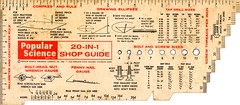Old-School Shop Guide
I rediscovered this super-compact reference-and-tool-and-measuring device while looking for a tool. It is jam-packed with handy information for anyone doing things mechanical or woodworking. I got this from a family friend of a family friend -- I bought their lathe after her husband, an avid (and skilled) woodworker, had passed away. She wanted his tools to go to someone who would love them and use them, which was me, which I do. The lathe is good, but I've discovered after the fact that the throwins were the best part. The chisels are *top notch*, but still pale in comparison to getting "his old woodworking magazines." This turned out to be almost every issue of Fine Woodworking magazine, beginning in its first year of publication; somewhere in the stack was this nifty Shop Guide.
I think this thing is so neat -- so much information in such a small space. My own mechanical data reference table (more here) has more numbers but less intrinsic functionality ... What's really neat about this shop guide is how they used the shape of the guide itself as a tool. Print this onto heavy cardstock and punch brother punch with care... enjoy!
Labels: data, design, fasteners, guide, info, infochimp, information, screws, shop, tool, vintage, woodworking



